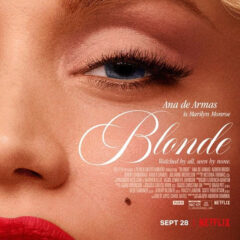
Blonde, the much maligned fictionalized biopic of Marilyn Monroe from director Andrew Dominik and based on the novel by Joyce Carol Oates, may just be the art film to end all art films.
It plays with color and sound, aspect ratio and focus, cameras and camera angles, light and darkness, and hard cuts and pans. Put simply, it’s all of the things you can do with a film all in one film.
This is an art film that would be probably more well received if it had been all fiction as opposed to being loosely based on fact. I’ve read that the book it’s based on is also a fictionalized account of Monroe’s life as well.
I hardly look at the consensus of reviews and critical acclaim from Rotten Tomatoes, but for this film to get 42% critically and 32% audience is proof that most audiences and critics don’t like something if it’s not polished in the standard style.
Personally, I think they all got it wrong. I loved this film, not for the content, but for the context and the style of it. Utilizing a mainly 4:3 aspect ratio that only expands to full widescreen in the way that I might use italics or bold type is an amazing choice.
Creating an ambiance in the film with silence or white noise, and not needing to fill every frame with a score of some kind, is impactful to the art you are witnessing.
 The lens flares and the cameras used are interesting statements, but it is the light that shines. Ana de Armas may be radiant in her portrayal of Marilyn, but when she is bathed in light and almost fades into the scene, it’s as important as the words that are coming out of her mouth. The same can be said for the shadow and the use of color and focus.
The lens flares and the cameras used are interesting statements, but it is the light that shines. Ana de Armas may be radiant in her portrayal of Marilyn, but when she is bathed in light and almost fades into the scene, it’s as important as the words that are coming out of her mouth. The same can be said for the shadow and the use of color and focus.
The point is, this is a film that film students will be dissecting for years to come. It will inspire the next generation of auteurs, because this film does not constrict itself to the conventions of those that have become the standard bearers for theaters and, more recently, streaming services.
Yes, just performing all of the technical things doesn’t make a film art. The fact that it kept me engaged and still fit together cohesively despite its disparity in techniques, however, is what sets this apart for me.
If you consider yourself a fan of art, take a look at this film. Don’t go into it thinking you’re going to get a biography of Marilyn Monroe, because that’s not what it is, and that preconceived notion will leave you disappointed. I honestly believe that the low scores are more of a reflection of the audience’s predisposition to that idea.
That said, leave your expectations at the door, sit back, and enjoy the show.
Read the Secret File of technical information and quotes from Blonde.